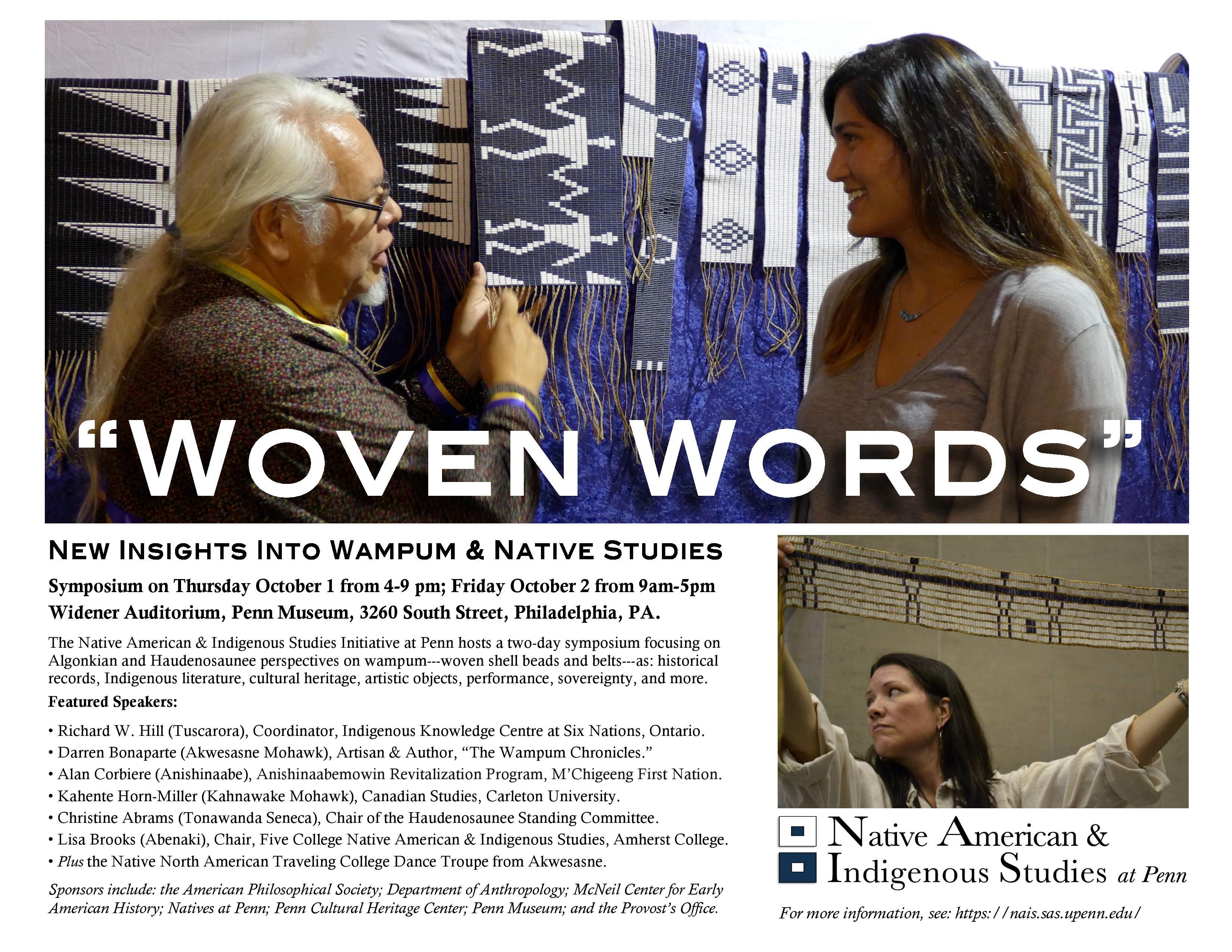Friday, October 2, 2015 - 9:00am to 5:00pm
Event Starts on Thursday October 1 from 4 to 9 pm
Event Continues on Friday October 2 from 9am to 5pm
Widener Lecture Room, Penn Museum
3260 South Street, Philadelphia, Pennsylvania 19104

“Woven Words: New Insights into Wampum and Native Studies”
October 1-2, 2015 Symposium at the Penn Museum
• • • CLICK HERE FOR FULL SCHEDULE OF EVENTS • • •
INVITED FIRST NATIONS/NATIVE AMERICAN PRESENTERS:
Richard W. Hill (Tuscarora), Coordinator, Deyohahá:ge: Indigenous Knowledge Centre at Six Nations, Ontario
“The Inherent Intelligence of Wampum”
This presentation will focus on how wampum captures the words, messages and meaning that the Haudenosaunee (People of the Longhouse) considered essential for future understandings, relationships and ways of being. We will explore the iconography of wampum belts, their metaphorical significance and the key messages to wampum that defines a Haudenosaunee identity. There will also be an examination of how wampum works in passing on the voice of the ancestors, as well as inspiration for the current generation of Haudenosaunee.
Kahente Horn-Miller (Kahnawà:ke Mohawk), School of Canadian Studies, Carleton University
“We are in Her and She is in Us: Revisiting the Skywoman Story”
This performative interpretation of the Sky Woman story contains teachings from the everyday lives of women who live in Kahnawà:ke and were the focus of the research. Narrated in the first person, her story illustrates that we are her great-granddaughters, but our story is no different. As Sky Woman strives to create a heaven on earth, the hardship and the healing that she experiences move her and her world forward. She is, to us mother, grandmother, peacemaker, mediator, elder, and finally Grandmother Moon who watches over all women for time eternal. In the words of her story we glimpse her inner identity: we see her as she sees herself because we are her and she is us. This story offers a connection, a path to reconnect with our ancestors in the Sky World.
Darren Bonaparte (Akwesasne Mohawk) Artisan and author of “The Wampum Chronicles”
“Wampum Belts of the Seven Nations: The Case for Cultural Continuity”
The largest known wampum belt, consisting of over 12,000 beads, was made by one of the mission villages that made up the Seven Nations of Canada. These communities are sometimes overlooked by those studying the Haudenosaunee because it is assumed that they had abandoned their traditional culture to follow strictly Christian teachings. The wampum record suggests otherwise. This presentation employs several wampum belts linked to the unique history of the Seven Nations that employ distinctive Haudenosaunee concepts. They are evidence of a stream of cultural continuity amid great political and social change.
Alan Corbiere (Anishinaabe), Coordinator, Anishinaabemowin Revitalization Program at M’Chigeeng First Nation
"The Spirit of my Words": Restoring Anishinaabe (Ojibwe/ Odawa) Understandings of Wampum”
The archival and oral tradition record is replete with references to the Anishinaabe receiving and delivering wampum strings and belts. However, many of the belts that were exchanged had no accompanying description, or if there was a description, it was minimal. This presentation will start by showing various belts known to be associated with the Anishinaabeg in order to then demonstrate the research conducted to re-create belts that have minimal description in the archives. The long term goal is to develop the Anishinaabe archive (repository) of wampum.
Lisa Brooks (Abenaki), Associate Professor of English and American Studies, Amherst College; Chair, Five College Native American & Indigenous Studies Program
“Writing and Wampum: Awikhigawôgan”
This presentation speaks broadly about wampum and writing, about the ways that both operated historically in Native networks as instruments that bound words to deeds and bound communities in alliance, but also worked as a material that could hold communal histories, which had to engaged.
I will also acknowledge, through Native writings and published oral traditions, that both wampum and writing hold ambivalent power -- which can potentially be used toward creation and destruction, peacemaking and war. I want to think about writing, reading and re-membering as activities in which we are engaged, which can be part of decolonization.
PLUS Native American Dance Performance & Trade Goods for Sale:
Native North American Travelling College Dance Troupe
from Akwesasne Mohawk Nation, Hogansburg, NY
Satekaronhioton Corey Fox, Teha'nikonhráthe Brant, Vicky Ransom, Amanda Tarbell
The Native North American Travelling College has been at the forefront of cultural education and revitalization since 1969. Their unique and innovative cultural centre publishes books, pamphlets and posters, produces audio-visual materials, hosts Native craft classes, and offers a group of traveling presenters that perform cultural heritage and living history, as part of the effort to share, teach, and support Native American culture, crafts, and performance. NNATC staffs a motivated team of eleven knowledgeable cultural educators, artists, public speakers and storytellers, who strive to revitalize traditional knowledge in Akwesasne while also educating their neighbors. They receive
part of their sponsorship from the Ontario Ministry of Tourism, Culture, and Sport. The dancers will also have crafts, books, and other items for sale to support their work.
Mark Humpal, Leatherworker and Fur Trader
This display features modern reproduction wampum beads and belts crafted by Native artisans from shell, glass, and clay beads, along with a wide range of furs, leatherwork, and other historic-style Native American crafts and trade goods. Mark has been trading with Native American artisans in the southwest and northeast for four decades, and he has widely shared the brain-tanning techniques he learned from the Apache. He will have a variety of items available for sale, including his edited volume of the re-published wampum treatise originally written by William Beauchamp in 1901. The highlight of this display is a collection of modern wampum beads and strings crafted from quahog shells by Poosepatuck artistans working along Long Island Sound, also available for sale.
For more information, contact:
Margaret Bruchac, Coordinator, Native American and Indigenous Studies (NAIS) at Penn
Department of Anthropology, University of Pennsylvania email: mbruchac@sas.upenn.edu

 Native American & Indigenous Studies at Penn
Native American & Indigenous Studies at Penn